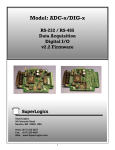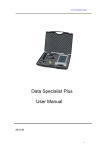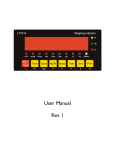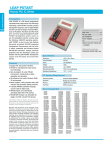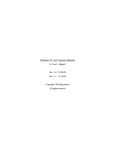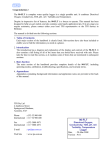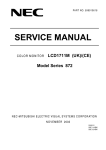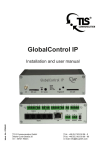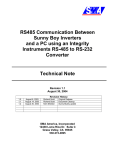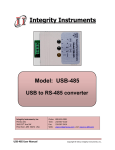Download Users Manual - Integrity Instruments
Transcript
Integrity Instruments 485M300 Series User Manual Integrity Instruments P.O. Box 451 Pine River Minnesota 56474 USA Order Phone Fax Phone Tech Phone 800-450-2001 218-587-3414 218-587-3120 http://www.integrityusa.com 485M300 Series I/O Modules Digital I/O Analog I/O 1 Integrity Instruments 485M300 Series User Manual Table of Contents Introduction Features.........................................................................................3 Quick Start ....................................................................................4 Communications RS-232 Packet Information ...........................................................6 Commands and Responses Command and Response Table ....................................................7 Command and Response Examples ............................................8 Analog Control Nibble ....................................................................9 Module Configuration EEPROM Map .............................................................................10 Sampling rates Analog and digital ........................................................................11 Mode of Operation Polled Mode .................................................................................11 Digital I/O Technical Information Digital I/O Characteristics ............................................................12 Digital I/O Port Configuration Example ........................................12 PWM Characteristics ...................................................................13 PWM Commands .........................................................................13 Analog I/O Technical Information Analog I/O Characteristics ...........................................................14 Voltage References .....................................................................14 Analog Voltage Sampling ............................................................14 Analog Conversion ......................................................................15 Analog Offset Calibration .............................................................15 Analog Current Sampling ............................................................16 Analog Current Conversion .........................................................16 Digital & Analog I/O Port Specifications Digital & Analog pinouts...............................................................17 Module Specifications PCB Illustrations ..........................................................................18 Dip switch and jumper settings ....................................................18 485M300 Series Module Specifications.......................................19 485 cable specifications...............................................................19 Peripherals Analog expander ..........................................................................20 Analog signal conditioner.............................................................20 Analog terminal strip ....................................................................20 2 Integrity Instruments 485M300 Series User Manual Introduction Welcome to the Integrity Instruments 485M300 Series of I/O modules. These modules using RS-485 communications are available in different configurations dependent on your needs and applications. In addition they are offered in an enclosure, or open allowing you the end user complete flexibility when determining the parameters for your project. Configurations for 485M300 models with enclosure are 485M300CE 16 digital I/O 485M3A0CE 16 digital I/O and 8 channels A to D conversion 485M3ADCE 16 digital I/O and 8 channels A to D conversion and 2 channels D to A conversion I/O Module features: MPU: EEPROM: MPU Clock: Interface: Baud: LED: Watchdog: POR: Brownout: Temperature: PCB: Power: Microchip PIC16C65B Microchip 25C040 14.7456 Mhz RS-485 (multidrop up to 255 nodes) 9600, 19200, 57600, 115200 (DIP switch selectable) Bicolor diagnostic LED MPU has built-in watchdog timer MPU contains timed Power On Reset circuitry MPU brownout detection ciruictry built-in 0° to 70°C (32° to 158°F) Commercial Temperature Range -40° to +85°C (40° to 185°F) Industrial Temperature Range FR4 7.5Vdc to 15.0Vdc, approximately 50 ma. 485M300 Series Features 16 Digital I/O lines Host Controller Address: 0 • • • • • 485M3A0 12 bit analog acquisition 16 bit digital I/O RS-485 multi-drop XP485-25E RS232-RS485 converter Peripheral Module Address: 1 8 12 bit Analog Inputs 2 12 bit Analog Outputs PWM Output 32 bit Pulse Counter 1 Mhz 1 pair wire 4000 feet 485M300 16 bit digital I/O Peripheral Module Address: 2 Up to 255 modules! 3 Integrity Instruments 485M300 Series User Manual Quick Start Instructions You need the following: • EZTerminal program available free on our website http://www.integrityusa.com • • • • An open COMPORT on your PC Power supply PS9J (9VDC 400 ma unregulated) A cable to connect your PC to your 485M300 I/O module If you use your com port you need a XP485-25E RS-232 to RS-485 converter Make these DIP switch settings for 115,200 baud SW1: ON SW2: ON (These are factory default settings, see page 22) Launch the EZTerminal program 1. 2. 3. 4. Double click the icon in whatever area you have put the program. Under “Settings” then choose Comport and select your RS-232 port, 115,200 Baud Rate, 8 Data Bits, NO PARITY, and 1 Stop Bits. Under “Settings” now choose “Terminal Settings”, and check the “Append LF to incoming CR” box, and “Local echo typed characters” check box. You may change the color of the transmitted and received characters by going under “Settings” and selecting “Colors” then “Transmit” or “Receive” and pick the color of your choice. Step 1 Steps 2 & 3 4 Integrity Instruments 485M300 Series User Manual Step 2 Step 3 Step 4 Step 4 Your First Command Now that you have a EZTerminal session running, your ready to power up the 485M300 Series I/O Module. After powering up your 485M300 Series Module, EZTerminal will receive a welcome message from the unit indicating you are ready to provide your first command. RS-485 Firmware Version Command: • Type 0100V and the Enter Key • You should see 0001V30 on the screen • NOTE: Make sure to type CAPITAL V, not lowercase v! After your first command, see Commands and Responses section for more commands. Screenshots and setup instructions performed running EZTerminal on a PC installed with Microsoft® Windows® XP Operating System. 5 Integrity Instruments 485M300 Series User Manual Communications The Integrity Instruments 485M300 Series modules use RS-485 as the communications interface. The interface uses simple ASCII commands. A carriage return (decimal code 13 or Hex code 0x0D) marks the end of a data packet. Line feeds (decimal code 10 or Hex code 0x0A) are ignored. RS-485 Interface: RS-485 operates Half Duplex • • • • • Each module (node) on the bus has a unique Address 1 to 254 (0x01-0xFE hex) We use the Linear Technologies RS-485 bus drivers (LTC1487) allowing up to 256 nodes on the RS-485 multi-drop bus Address 0 (0x00 hex) is reserved for the Host controller Address 255 (0xFF hex) is reserved for Broadcast messages. Address 0xFF is ccepted by all modules on the RS-485 bus. RS-485 Packet Format Destination Address xx Source Address xx Command/Response ASCII CR carriage return 13 (0x0D hex) x = ASCII Hexadecimal Digit Address 0x00 Address 0x01-0xFE Address 0xFF Host Device (IBM-PC, micro-controller, etc.) I/O Module Address Broadcast Address (used to configure an I/O Module) Commands and Responses The following table illustrates the Integrity Instruments I/O module commands and responses. NOTE All numeric data is represent as ASCII Hexadecimal integers (value x/y in the table) • If a module receives an illegal or improperly formatted command, Error Response is sent. • All ASCII characters are CASE SENSITIVE (use all capital letters!) • 6 Integrity Instruments 485M300 Series User Manual Commands and Responses v3.0 Firmware Command Sent by Host Response Sent by I/O Module Description V Vxy Firmware version x.y I Ixxyy Input digital port status xx = PORT1 yy = PORT2 Also returns current output port status Oxxyy O Output digital port: xx = PORT1 yy = PORT2 Txxyy T Set digital direction: xx = PORT1 yy = PORT2 bit set(1) = Input, bit clear(0) = Output G Gxxyy Get current digital direction: xx = PORT1 yy = PORT2 bit set(1) = Input, bit clear(0) = Output N Nxxxxxxxx Get Pulse Counter (xxxxxxxx 32 bit counter value) M M Clear Pulse Counter Qy Qyxxx Bipolar sample analog (y control nibble, xxx analog value) Uy Uyxxx Unipolar sample analog (y control niblle, xxx analog value) Lyxxx L D/A output y (channel setting 0 or 1), xxx 12 bit D/A output) K Kxx Get receive error count (xx current count) J J Clear receive error count Pxxyyy P PWM (xx = PWM frequency, yyy = PWM duty) Wyyxx W Write EEPROM (yy address, xx value) Ryy Rxx Read EEPROM (yy address in command, xx value in reponse) Z Z Reset CPU X Command error response 7 Integrity Instruments 485M300 Series User Manual RS-485 Interface Example Commands The following table illustrates actual command and response data for an RS-485 interface. NOTE All numeric data is represent as ASCII Hexadecimal integers • • • Example Host Address = 0x00 and Module Address = 0x13 The symbol ↵ equates to a carriage return (decimal 13, hex 0x0D) Command Sent by Host Response Sent by I/O Module Description 1300V↵ 0013V30↵ Module Firmware version 3.0 1300I↵ 0013IFF00↵ Input digital port [PORT1 bits0-7 ON] [PORT2 bits0-7 OFF] Note: this command also returns the current digital output 1300O007F↵ 0013O↵ Output digital port [PORT1 bits 0-7 OFF] [PORT2 bit 7 OFF, bits 0-6 ON] 1300TFF80↵ 0013T↵ Set digital direction [PORT1 bits 0-7 INPUT] [PORT2 bit 7 INPUT, bits 0-6 OUTPUT] 1300G↵ 0013GFF80↵ Get current digital direction [PORT1 bits 0-7 INPUT] [PORT2 bit 7 INPUT, bits 0-6 OUTPUT] 1300N↵ 0013N0000000F↵ Get pulse counter: Current count = 15 1300M↵ 0013M↵ Clear pulse counter: Current count = 0 1300Q1↵ 0013Q100F↵ Bipolar analog control nibble = 0x1 Analog reading = 0x00F 1300U8↵ 0013U840F↵ Unipolar analog control nibble = 0x8 Analog reading = 0x40F 1300L1800↵ 0013L↵ D to A Output Channel 1 = 2.5 Volts 1300K↵ 0013K00↵ Current receive errors = 0 1300J↵ 0013J↵ Clear receive error count: Current receive 1300P4801F↵ 0013P↵ PWM freq = 50499 Hz, PWM duty = 10.6% 1300W0410↵ 0013W↵ Write EEPROM Address 0x04 with value 0x10 1300R04↵ 0013R10↵ Read EEPROM Adress 0x04 (value is 0x10) 1300Z↵ 0013Z↵ Reset CPU (forces a watchdog timeout after 8 Integrity Instruments 485M300 Series User Manual Analog Control Nibble and Example The 485M300 Series modules utilizes the Linear Technologies LTC1296 analog to digital conversion chip. In the process of performing a data sample, the user sends a control nibble to the 485M300 module. The module in turn performs a data conversion using the control nibble and transmitts a response data sample back. The following table lists each of the 16 possible analog configurations. NOTE All numeric data is represent as ASCII Hexadecimal integers • • • The symbol ↵ equates to a carriage return (decimal 13, hex 0x0D) See Technical Info section for sample to volts conversion Control Nibble Sent by Host Analog Sample 0 Differential: CH0+ CH1- 1 Differential: CH2+ CH3- 2 Differential: CH4+ CH5- 3 Differential: CH6+ CH7- 4 Differential: CH0- CH1+ 5 Differential: CH2- CH3+ 6 Differential: CH4- CH5+ 7 Differential: CH6- CH7+ 8 Single Point: CH0 9 Single Point: CH2 A Single Point: CH4 B Single Point: CH6 C Single Point: CH1 D Single Point: CH3 E Single Point: CH5 F Single Point: CH7 Command Sent by Host Response Sent by I/O Module Description 1300Q0↵ Q000F↵ Bipolar sample differential CH0+ CH1(Control = 0) Analog sample = 0x00F (decimal 15) 1300UA↵ UA123↵ Unipolar sample CH4 (Control = A ) Analog sample = 0x123 (decimal 291) 9 Integrity Instruments 485M300 Series User Manual EEPROM Map: Address Description 0x00 Module Address (RS-485 address) [factory default = 0x01] 0x01 N/A - Reserved 0x02 Data Direction Port 1 Bit set (1) = Input Bit clear (0) = Output [factory default = 0xFF] 0x03 Data Direction Port 2 Bit set (1) = Input Bit clear (0) = Output [factory default = 0xFF] 0x06 Port 1 Power on Default output [factory default = 0x00] 0x07 Port 2 Power on Default output [factory default = 0x00] 0x08 See Note 1 Expander board flag (Opto-22 modules attached) 0x00 = No expander board attached 0xFF = Expander board attached (invert digital signals) [factory default = 0x00] 0x09/0x0A D/A Channel 0 Power on Default output 12 bits - upper nibble in 0x09, lower byte in 0x0A [factory default = 0x000] 0x0B/0x0C D/A/ Channel 1 Power on Default output 12 bits - upper nibble in 0x0B, lower byte in 0x0C [factory default = 0x000] 0x0D See Note 2 A/D Channels sample clock rate 0x00 = Normal A/D Channels sample clock rate 0xFF = Slowed A/D Channels sample clock rate [factory default = 0x00] 0X04, 0X05, 0x0E, 0x0F N/A - Reserved 0x10….0xFF Available to User WARNING! The I/O Module CPU must be reset before new EEPROM settings take effect. NOTE 1. This flag is used when an expander board is attached. It allows for polarity interface to the industry standard I/O modules used with the expander board based on open collector logic that these modules use. 2. This is used to slow the A/D Channel sample clock rate. This may help when the A/D channels have a high impedance input attached. 10 Integrity Instruments 485M300 Series User Manual Analog& Digital I/O Sampling Rates Analog I/O Baud Rate Delayed Response No Delayed Response 115,200 141 486 57,600 123 257 19,200 62 89 9600 37 45 Digital I/O Baud Rate Delayed Response No Delayed Response 115,200 164 523 57,600 123 273 19,200 66 94 9600 39 47 Sampling rates are in samples per second for a single analog channel or 8 bit digital I/O port tested on Windows 2000 850 Mhz P3 with A/D clock running at full speed. Samples per channel = Sample rate ÷ number of channels being sampled. Modes of Operation: The Integrity Instruments 485M300 Series I/O modules operates in the Polled Mode. Polled Mode The Polled Mode is the most common usage of the 485M300 Series I/O modules. In this mode the Host computer sends a command to the I/O Modules which in turn sends an associated response back to the Host computer. 1 - Command Sent by Host HOST Computer 2 - Response Sent by Module I/O Module 485M300 Series 11 Integrity Instruments 485M300 Series User Manual Digital I/O Characteristics The following chart lists the Digital I/O characteristics and values. Characteristic Value Digital I/O Current I/O line source & sink 25 ma Total current PORT1 200 ma Total current PORT2 200 ma Digital I/O Voltage Levels Input Off (0) = 0V - 0.8V Input On (1) = 2.0V - 5.0V Output Off (0) = 0.6V max. Output On (1) = 4.3V min. Pulse Counter Input 1 Mhz max. input rate 32 bit counter capture Counter increments on high-low transition Digital Port Configuration Example Any Digital I/O configuration changes made to the I/O Module using the ‘T’ command are stored in EEPROM locations 0x02 and 0x03. EEPROM Location 0x02 EEPROM Location 0x03 Port 1 I/O Configuration Port 2 I/O Configuration When using either the ‘T’ command or directly writing to EEPROM using the ‘W’ command, a binary 1 at a bit location puts the I/O line into Input mode, while a binary 0 at a bit location puts the I/O line into Output mode. NOTE All numeric data is represent as ASCII Hexadecimal integers • • The symbol ↵ equates to a carriage return (decimal 13, hex 0x0D) Host Command Module Response Action T0000↵ T↵ All I/O lines are configured as Outputs TFFFF↵ T↵ All I/O lines are configured as Inputs TFF00↵ T↵ Port 1 bits 0-7 Inputs Port 2 bits 0-7 Outputs T00FF↵ T↵ Port 1 bits 0-7 Outputs Port 2 bits 0-7 inputs T1234↵ T↵ Port 1 bits 4,1 Inputs Port 1 bits 7,6,5,3,2,0 Outputs Port 2 bits 4,5,2 Inputs Port 2 bits 7,6,3,1,0 Outputs 12 Integrity Instruments 485M300 Series User Manual Pulse Width Modulation (PWM) Characteristics The 485M300 Series modules have a configurable PWM output. There are two settings to configure for proper PWM operation: PWM frequency and PWM duty cycle. PWM — Command Pxxyyy xx = Pwm_Divisor yyy = Pwm_Duty (10 bits max.) Pwm_Divisor = 0x00 ... 0xFF Pwm_Duty = 0x000 ... 0x3FF Pwm_Duty = 0, PWM output is disabled (output 0) PWM — Control Values (14.7456 Mhz clock) PWM Period = (Pwm_Divisor + 1) / 3686400 PWM Duty Period = (Pwm_Duty) / 14745600 Duty_Resolution = log (14745600/ Fpwm) / log (2) PWM Duty Cycle % = PWM Duty Period / PWM Period if (PWM Duty Period > PWM Period) then PWM Duty Cycle = 100% Pwm_Divisor PWM Freq Duty_Resolution 0xFF (255) 14400 Hz 10 bits* (see note) 0xFE (254) 14456 Hz 10 bits 0x5B (91) 40069 Hz 8 bits 0x00 (0) 3686400 Hz 2 bits * Note: Pwm_Divisor 0xFF cannot achieve complete 100% duty cycle. Use Pwm_Divisor 0xFE if 100% duty cycle is required. Example PWM Commands All numeric data is represent as ASCII Hexadecimal integers • • The symbol ↵ equates to a carriage return (decimal 13, hex 0x0D) Host Command Module Response Action P0000↵ P↵ PWM off Any duty cycle of 0 disables PWM output P4801F↵ P↵ PWM frequency = 50499 Hz PWM duty = 10.6% PFE3FF↵ P↵ PWM frequency = 14456 Hz PWM duty = 100% PFE1FE↵ P↵ PWM frequency = 14456 Hz PWM duty = 50% 13 Integrity Instruments 485M300 Series User Manual Analog I/O Characteristics: Characteristic A/D Converter Value Linear Tech LTC1296BCN ± .5 LSB Linearity Error LTC1296BCN ± 0.012% (± .5 LSB) Gain Error ± 0.012% (± .5 LSB) Offset Error ± 0.17% Temperature Drift 100 ppm/ºC ( max. ) Max Input Voltage 5V D/A Converter Offset Error Linear Tech LTC1448 ± 10 mv LTC1296 Operation The analog inputs of the LTC1296 look like a 100pf capacitor (Cin) in series with a 500 Ω resistor (Ron). Cin gets switched between (+) and (-) inputs once during each conversion cycle. Large external source resistors and capacitances will slow the settling of the inputs. It is important that the overall RC time constant is short enough to allow the analog inputs to settle completely within the allowed time. The voltage on the inputs must settle completely within the sample period. Minimizing Rsource will improve the settling time. If large source resistance must be used, the sample time can be increased by using a slower CLK frequency. Sampling Analog Voltage Inputs By far the most common configuration of the 485M300 Series I/O modules is to sample voltage values. Analog voltage levels are converted to integer digital values using the Linear Technologies LTC1296 A/D (Analog/Digital) chip. The input voltage range is determined by the reference voltage. There are two analog sample types: 1) Unipolar 2) Bipolar Both A/D sampling types result in a 12 bit binary integer value. Vref = 5.000 standard Unipolar Analog Sampling Resolution Unipolar analog sampling span is from ground (GND) to voltage reference (Vref). Only positive voltages are sampled in unipolar mode. The unipolar sample is represented as an unsigned integer as follows: Unipolar voltages: 0V ... +Vref The benefit of using Unipolar samples over Bipolar samples is that a 12 bit binary value is spread out over less total voltage span (Vref total.) 1 LSB unipolar = Vref/4096 1 LSB unipolar = 5.000/4096 1 LSB unipolar = 0.0012207 volt 14 Integrity Instruments 485M300 Series User Manual Bipolar Analog Sampling Resolution Bipolar analog sampling span is from -Vref to +Vref. Both negative and positive voltages are sampled and represented as a signed binary integer (2’s complement) as follows: Bipolar voltages: -Vref ... 0 ... +Vref The benefit of using Bipolar sampling over Unipolar is obvious, negative voltages! The downfall of using Bipolar sampling is that a 12 bit binary value is spread out over a larger total voltage span (2*Vref total.) 1 LSB bipolar = Vref/2048 1 LSB bipolar = 5.000/2048 1 LSB bipolar = 0.0024414 volt Voltage Conversion The Analog conversion value obtained from the 485M300 Series module is represented as an integer value (either signed for Bipolar samples or unsigned for Unipolar sample) and is normally converted to a Real or Floating Point number for ultimate usage. Vref = 5.000 standard Unipolar Voltage Conversion Formula Volts [unipolar] = ADC_Sample * (5.000/4096) Volts [unipolar] = ADC_Sample * 0.0012207 Bipolar Voltage Conversion Formula The following assumes that ADC_Sample is an unsigned integer value. if (ADC_Sample >= 2048) Volts [bipolar] = (ADC_Sample-4096) * (5.000/2048) if (ADC_Sample <= 2047) Volts [bipolar] = ADC_Sample * (5.000/2048) if (ADC_Sample >= 2048) Volts [bipolar] = (ADC_Sample-4096) * 0.0024414 if (ADC_Sample <= 2047) Volts [bipolar] = ADC_Sample * 0.0024414 15 Integrity Instruments 485M300 Series User Manual Sampling Current (4-20 ma) Inputs Many devices output a current value instead of a voltage value. The secret to obtaining current readings is a 250 ohm resistor. Placing a 250 ohm resistor to ground on a 4-20 ma. current input will create a voltage potential of 1V to 5V. If we remember Ohm’s law: E=I*R R = 250 ohms I = .004 to .020 amps (4-20 ma.) E = 1.0V to 5.0V Obtaining current readings is a three step process: 1. Perform analog Unipolar sample 2. Convert unipolar sample to volts 3. Convert voltage to amps The following formula will convert the raw analog sample reading to a current value. Current = (ADC_Sample * (5.000/4096)) / 250 Obtaining accurate Analog samples Please keep the following points in mind when attempting to obtain accurate samples. • • • • • • Avoid high impedance analog signal sources! Watch out for UPS systems! They create loads of EMI/EMF noise. Keep the analog signal source as close to the ADC-x module as possible. Keep transformers far away from the 485M300 Series module. Use good wiring practices, especially in regards to ground connections. RS-232 interface can generate approx. 2 mv noise. Resistors for Analog and Digital I/O The digital I/O points have a 100K Ω resistor to ground to prevent floating inputs. The analog inputs have a 560 Ω resistor in series to afford some protection to the A to D converter. From input 16 To cpu input From analog input To a/d input Integrity Instruments 485M300 Series User Manual Digital & Analog I/O Port Pin outs And Hex Conversion Chart Analog I/O DB15 Pins EXAMPLE HEX CONVERSION X X Y Y BITS 1 1 0 0 1 0 0 0 1 0 1 1 0 1 1 1 HEX C 8 B 7 Digital I/O DB25 Pins 1 Description Port 2 Bit 0 2 Port 2 Bit 1 3 Port 2 Bit 2 1 ANALOG IN CHANNEL 7 2 ANALOG IN CHANNEL 6 3 ANALOG IN CHANNEL 5 4 ANALOG IN CHANNEL 4 5 ANALOG IN CHANNEL 3 6 ANALOG IN CHANNEL 2 7 ANALOG IN CHANNEL 1 8 ANALOG IN CHANNEL 0 9 GND 10 + V UNREG 11 + 5VDC REG 12 - V UNREG 13 V REFERENCE 14 ANALOG OUT B 15 ANALOG OUT A PORT 1 X Description PORT 2 X Y Y 4 Port 2 Bit 3 5 Port 2 Bit 4 6 Port 2 Bit 5 7 Port 2 Bit 6 8 Port 2 Bit 7 9 PWM output 10 N/A 0 0 0 0 0 0 0 0 0 0 0 0 0 0 0 0 0 0 0 0 11 +V Unreg 1 0 0 0 1 1 0 0 0 1 1 0 0 0 1 1 0 0 0 1 12 +5Vdc 2 0 0 1 0 2 0 0 1 0 2 0 0 1 0 2 0 0 1 0 13 GND 3 0 0 1 1 3 0 0 1 1 3 0 0 1 1 3 0 0 1 1 14 Port 1 Bit 0 4 0 1 0 0 4 0 1 0 0 4 0 1 0 0 4 0 1 0 0 15 Port 1 Bit 1 5 0 1 0 1 5 0 1 0 1 5 0 1 0 1 5 0 1 0 1 16 Port 1 Bit 2 6 0 1 1 0 6 0 1 1 0 6 0 1 1 0 6 0 1 1 0 17 Port 1 Bit 3 7 0 1 1 1 7 0 1 1 1 7 0 1 1 1 7 0 1 1 1 18 Port 1 Bit 4 8 1 0 0 0 8 1 0 0 0 8 1 0 0 0 8 1 0 0 0 19 Port 1 Bit 5 9 1 0 0 1 9 1 0 0 1 9 1 0 0 1 9 1 0 0 1 20 Port 1 Bit 6 A 1 0 1 0 A 1 0 1 0 A 1 0 1 0 A 1 0 1 0 21 Port 1 Bit 7 B 1 0 1 1 B 1 0 1 1 B 1 0 1 1 B 1 0 1 1 22 Pulse Counter Input C 1 1 0 0 C 1 1 0 0 C 1 1 0 0 C 1 1 0 0 23 -V Unreg D 1 1 0 1 D 1 1 0 1 D 1 1 0 1 D 1 1 0 1 24 +5Vdc E 1 1 1 0 E 1 1 1 0 E 1 1 1 0 E 1 1 1 0 25 GND F 1 1 1 1 F 1 1 1 1 F 1 1 1 1 F 1 1 1 1 H BIT H BIT H BIT H BIT E VALUE E VALUE E VALUE E VALUE X X X X V 7 6 5 4 V 3 2 1 0 V 7 6 5 4 V 3 2 1 0 A A A A L L L L U U U U E E E E 17 Integrity Instruments 485M300 Series User Manual Model 485M300 Series LED Communications Power/Port J1 Power DIP switch JP4 JP3 JP5 Digital I/O U8 Analog Input Output U1 U3 U6 U5 U 10 U4 485M300 Series IC descriptions IC Model 485M3AD (Position and type is the same for all models) U1 PIC16C65B MPU U3 LTC1487 RS-485 driver [8 pin DIP] U4 25C040 EEPROM [8 pin DIP] U5 LTC1296 A to D [20 pin DIP] U6 LM4040AIZ-5.0 0.1% Voltage Reference U8 LMC555 Timer charge pump [8 pin DIP] U10 LTC1448 D to A [8 pin DIP] Baud Rate Switch and Jumper Settings 18 SW1 SW2 Baud Rate Jumper Settings (factory default) OFF OFF 9600 baud JP3/JP4 On 485 termination ON OFF 19200 baud OFF ON 57600 baud ON ON 115200 baud (factory default) JP5 On Approx 2ms Delayed Response Integrity Instruments 485M300 Series User Manual 485M Series Module Specifications LED Operation Blinking Green Blinking Green Blinking Red No LED [1 per Second] [Rapid or Steady] [Rapid or Steady] Unit functioning correctly - idle Unit receiving serial data Unit transmitting serial data Unit is not functioning Power Supply 7.5-15.0Vdc approx. 50 ma. (we suggest our PS9J 9VDC 400 ma unregulated] ) GND and Shield The GND and Shield terminals are connected on the 485M300 Series boards and are therefore electrically equivalent. SHLD + PWR GND B A 485M300 active termination +5V J1 R1 1.2K + VDC JP3 JUMPER SIGNAL A 485 DRIVE GND R4 10 R3 120 Power 2.5mm JP4 JUMPER 1 2 R5 10 R2 1.2k SIGNAL B Power Connector on board wiring RS-485 Cabling The 485M300 Series is designed to operate in a Multi-Drop RS-485 LAN configuration. In a half-duplex mullti-drop environment all RS-485 nodes share the same data lines. A single pair of data lines act as both Transmit and Receive wires. * Data lines (A/B) are the only wires required between RS-485 nodes * All RS-485 nodes need not share the same V+ and GND Cabling Notes: 1) 2) 3) 4) 5) Gnd and Shld are connected internally within the 485M300 Series modules Cable termination is important for long distanceand high-speed applications Suggested cable: 24 awg stranded twisted pair with shield for cable runs in excess of 200 feet. See also Belden cable #9841 and #9463. The normal connection method is the “Daisy Chain” type shown below. there are other kinds of connections, but this is considered as the standard. The end units (END 1) and (END 2) should be terminated. All other units should not. RS-485 DEVICE END 1 RS-485 DEVICE RS-485 DEVICE RS-485 DEVICE RS-485 DEVICE RS-485 DEVICE END 2 DAISY CHAIN 19 Integrity Instruments 485M300 Series User Manual Peripheral Add-On Modules AE-8CH ASC-2CH DB15TSM DB25TSM EXP-x 8 channel analog connection board 2 channel signal conditioner DB15 terminal strip (for analog connector) DB25 terminal strip (for digital connector) Digital Interface board Model: AE-8CH Analog Connection Board Jumper configurable analog inputs: 1) 4-20 ma inputs 2) +/- 10 Vdc inputs 3) Solid state temperature probes Handy terminal strip for all analog connections and voltages. MTA .100 jacks are also available for solid state temperature probes available from Integrity Instruments. Model: ASC-2CH Signal Conditioning Board 2 channels of precision instrumentation amplifiers. Gains of 1, 10, 100, 1000 Handy terminal strip for all analog connections and voltages. Models: DB15TSM and DB25TSM DB Terminal Strip Terminal strip boards to conveniently connect to DB15 and DB25 connectors. Models: EXP-x Digital Interface Board The EXP-X unit provides for digital interface and signal conditioning via industry standard opto-isolated I/O modules such as Opto-22. Each unit has 4 I/O points with large easy to use terminal screws. If more I/O points are required, simply plug in another unit up to 16 total I/O points. Opto isolated modules: 90V-140V AC input, 12V-140V AC output, 3.3V32V DC input, 3V-60V DC output. WARRANTY Integrity Instruments warranties all products against defective workmanship and components for the life of the unit. Integrity Instruments agrees to repair or replace, at it’s sole discretion, a defective product if returned to Integrity Instruments with proof of purchase. Products that have been mis-used, improperly applied, or subject to adverse operating conditions fall beyond the realm of defective workmanship and are not convered by this warranty. Copyright © 2000-2003, Integrity Instruments, Inc. All trademarks and/or registered trademarks are the property of their respective owners. Revision: January 3, 2005 - v3.0 20






















